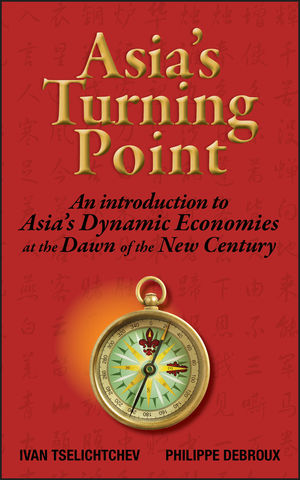Asia's Turning Point: An Introduction to Asia's Dynamic Economies at the Dawn of the New CenturyISBN: 978-0-470-82360-6
Hardcover
350 pages
March 2009
 This is a Print-on-Demand title. It will be printed specifically to fill your order. Please allow an additional 15-20 days delivery time. The book is not returnable.
|
||||||
Acknowledgments xiii
Prologue 1
Part 1: Region 5
Chapter 1: The East Asian Miracle in Retrospect 7
Similarity in Diversity 7
Why Rapid Growth? 10
The East Asian Model of Capitalism: An Outline 10
The East Asian Model of Capitalism: How It Worked for Growth 14
The Asian Crisis: The Final Curtain 16
Entering a New Stage 20
Chapter 2: A New Wave of Growth 23
East Asia in the World: Its Present Position 24
Running Fast But Slowing Down 28
Labor and Capital: Inputs and Productivity 29
Growth Drivers on the Demand Side 36
China-led Growth 36
The Growth of Poor Quality: Energy Inefficiency and Environmental Unfriendliness 38
The Impact of the Global Financial Turmoil 40
Concluding Remarks 44
Chapter 3: Structural Transformation: The State 47
The Developmental State is Yesterday 47
“Less Government, More Market” 49
Industrial Policy: Still There, But… 51
An Emphasis on Upgrading and Innovation 56
Modernizing Agriculture: A New Old Task 57
SOEs and GLCs as Leaders in the Market Economy 60
Concluding Remarks 63
Chapter 4: Structural Transformation: Business 65
Three Big Shifts 65
Ownership Shift 66
Corporate Governance Shift 77
Dominant Shareholders: A New Mentality, a New Mode of Action 81
Concluding Remarks 85
Chapter 5: Structural Transformation: Labor Relations 87
Overview: Directions of Change and New Challenges 87
Evolving Practices and Way of Thinking 88
The Signs of a New HRM System 90
Building Sustainable Labor Relations 92
Concluding Remarks 96
Chapter 6: Regional Integration and Prospects for the East Asian Community 97
The Interdependence of East Asian Economies 98
East Asia’s FTAs 103
Regional Institution Building: ASEAN Plus Three 108
The Creation of the East Asian Community: Dilemmas 111
East Asia’s Integration Pattern: A“Do-What-You-Can-Do” Community 113
Part 2: Nations 115
Chapter 7: China: A New Heavyweight 117
A Few Basics 117
Postwar Development 118
Structural Reforms 122
Present Performance 123
Three Super-Challenges 127
The Upgrading Game 129
Foreign Trade 132
FDI and the Business Environment 135
Concluding Remarks 138
Chapter 8: Hong Kong: Ten Years with China 143
A Few Basics 143
An Historical Perspective 145
Postwar Development 146
Present Performance 146
Foreign Trade 151
FDI and the Business Environment 152
Concluding Remarks 153
Chapter 9: Taiwan: A Center of Advanced Manufacturing 155
A Few Basics 155
Postwar Development 156
Structural Reforms 159
Present Performance 159
Foreign Trade 164
FDI and the Business Environment 165
Concluding Remarks 167
Chapter 10: South Korea Reformed: Challenges for a Newly Developed Nation 169
A Few Basics 169
Postwar Development 170
Structural Reforms 173
Present Performance 175
Foreign Trade 179
FDI and the Business Environment 180
Concluding Remarks 183
Chapter 11: Singapore: Globalized, Entrepreneurial, Diversified 185
A Few Basics 185
Postwar Development 187
Structural Features 190
Present Performance 191
Foreign Trade 196
FDI and the Business Environment 197
Concluding Remarks 198
Chapter 12: Malaysia: Developed by 2020? 201
A Few Basics 201
Postwar Development 203
Structural Reforms 206
Present Performance 207
Foreign Trade 211
FDI and the Business Environment 211
Concluding Remarks 214
Chapter 13: Thailand: Rice Bowl, Regional Factory, and Land of Smiles 215
A Few Basics 215
Postwar Development 216
Structural Reforms 220
Present Performance 221
Foreign Trade 227
Inward FDI and the Business Environment 228
Concluding Remarks 232
Chapter 14: Indonesia: The Start of the Post-Suharto Era 235
A Few Basics 235
Postwar Development 238
Structural Reforms 242
Present Performance 244
Foreign Trade 248
FDI and the Business Environment 250
Concluding Remarks 252
Chapter 15: Philippines: Speeding up at Last 255
A Few Basics 255
Postwar Development 256
Structural Reforms 260
x Asia’s Turning Point
Present Performance 261
Foreign Trade 266
Inward FDI and the Business Environment 266
Concluding Remarks 269
Chapter 16: Vietnam: A New Magnet for Investors? 271
A Few Basics 271
Postwar Development 271
Structural Reforms (The 1990s and the 2000s) 273
Present Performance 275
Foreign Trade 279
FDI and the Business Environment 280
Concluding Remarks 283
Chapter 17: North Korea: Utter Orthodoxy or Attempts to Reform? 285
A Few Basics 285
Postwar Development 286
Structural Reforms 287
Present Performance 290
Foreign Trade 291
FDI and the Business Environment 292
Economic Relations with South Korea 293
Concluding Remarks 294
Chapter 18: The Russian Far East: Yes, It is Also East Asia! 297
A Few Basics 297
The RFE in the Soviet Economy 298
The Market Transition of the 1990s 299
Present Performance 300
Foreign Trade 303
Inward FDI and the Business Environment 304
Concluding Remarks 307
Chapter 19: India: The Next-Door Neighbor Knocking at the Door 309
A Few Basics 309
Postwar Development 311
Structural Reforms 313
Present Performance 314
Foreign Trade 321
FDI and the Business Environment 322
Concluding Remarks 325
Chapter 20: Japan: Forgotten Giant 327
A Few Basics 327
Postwar Development 329
Structural Reforms 334
Present Performance 336
Foreign Trade 343
FDI and the Business Environment 345
Concluding Remarks 348
Epilogue 351
References 355
Index 371



